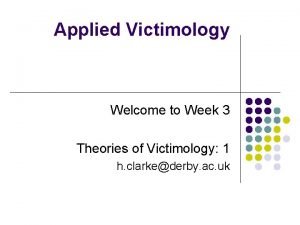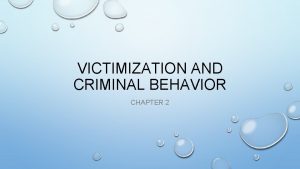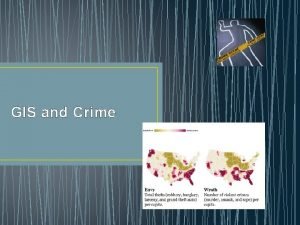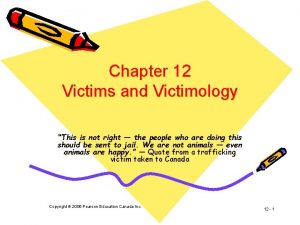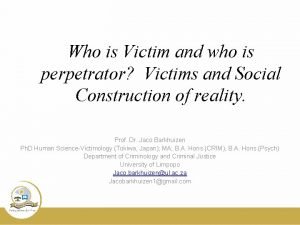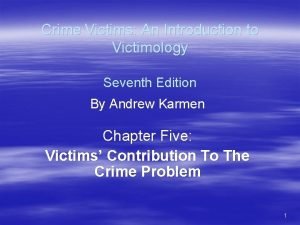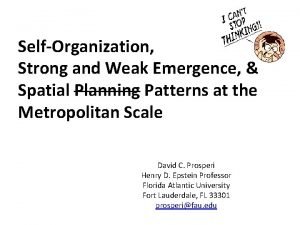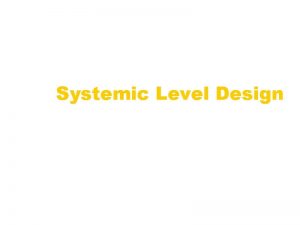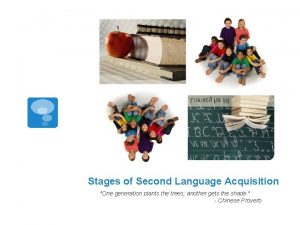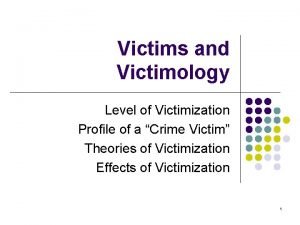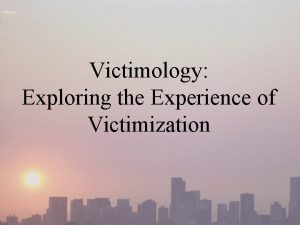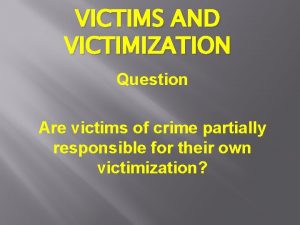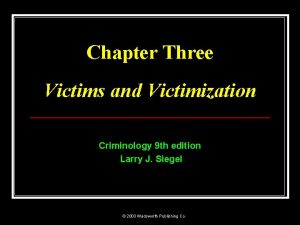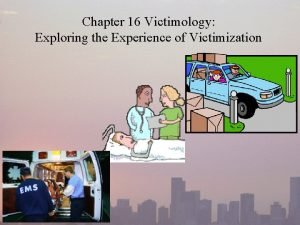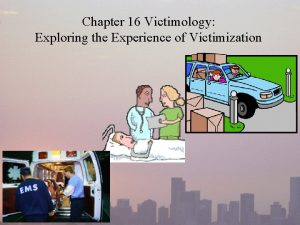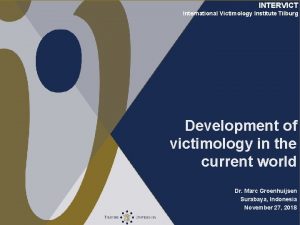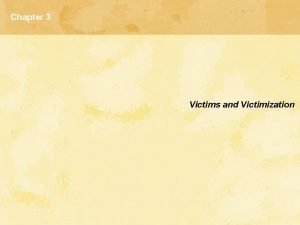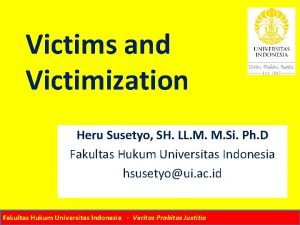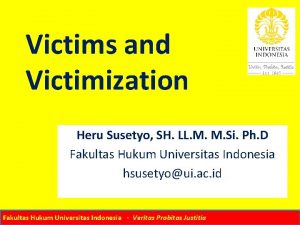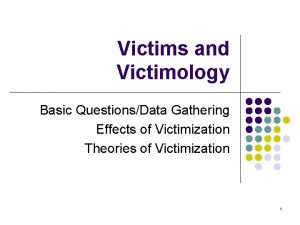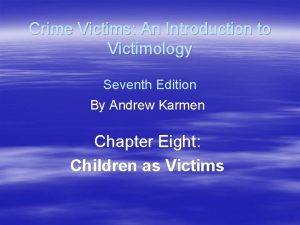Chapter Three Victims and Victimization Emergence of Victimology

















- Slides: 17

Chapter Three: Victims and Victimization

Emergence of Victimology and Victimologists l l For many years victims were just looked at as people who were “in the wrong place at the wrong time. ” Starting in the 1960 s researchers saw that victims sometimes play a role in a criminal incident l Active role l Indirect role Victimology l The study of the victim’s role in criminal events Victimologists l Criminologists who specifically focus on the victims of crime

Problems of Crime Victims l l l Estimated 23 million annual victimizations in the U. S. These crimes can have short and long term consequences on the victim and society These include: l l l Economic loss System abuse Long term stress Fear Antisocial Behavior

The Nature of Victimization l Since 1993 the number of victimizations are declining l l Patterns of victimization are stable l l l NCVS Data Victimization is not random Becoming a crime victim has a lot to do with personal and ecological factors How is this useful? l l Researchers can make judgments about the nature of victimization Efforts can be made to reduce the victimization rate

The Social Ecology of Victimization l l l Violent crimes are slightly more likely to occur in a public area during daytime or early evening hours More serious violent crimes typically occur after 6 p. m. to 6 a. m. l Rape and aggravated assault Less serious violent crimes more likely occur in the day l Purse snatching and unarmed robberies The risk of murder is highest in disorganized inner-city areas Rural areas have significantly lower victimization rates than urban areas (half as much) Schools are also the location of many victimization l Numbers are decreasing

The Victim’s Household l In the U. S. certain homes are more vulnerable to crimes l l l Larger homes (family size) African American Renters Western and urban homes l Rural white homes in the Northeast are least likely to contain crime victims Reasons for decrease in victimizations based on current household trends? ? ?

Important Victim Characteristics l l l Gender Age Social status Marital status Race and Ethnicity Repeat victimization

l Gender l Males are more likely to be the victims of violent crimes (robbery/assault) l l Two thirds of women are victimized by someone they know or live with l l Except for rape or sexual assault Half of male victims are attacked by someone they know With the increase in gender equality, women’s victimization rates are as well l Age l l l Young people have a much higher victimization rate Victim risk rapidly diminishes after age 25 By age 65 chances of being victimized greatly decrease l 1% of violent victimizations § l With increases in reports of elder abuse, victimization rates for the elderly will increase More likely to be victims of crimes such as § § Frauds and scams Purse snatching

l Social Status l The poorest Americans are the most likely victims of violent and property crime l l Regardless of age, gender, and race The wealthy are more likely the targets of personal theft crimes l Marital Status l l l Never-married men and women have higher victimization rates than married people Widows and widowers have the lowest victimization rate The relationship between marital status and victimization is probably influenced by gender, age, and lifestyle

Race and Ethnicity l l l African Americans are more likely than whites to be victims of violent crime Due to income inequality, many racial and ethnic minorities live in deteriorated urban areas with high rates of violence Overall the rate of black victimization is on the decline

Routine Activities Theory l The view that victimization results from the interaction of three everyday factors: • • • Suitable targets • objects of crime that are attractive and readily available Absence of capable guardians • effective deterrents to crime, such as police Presence of motivated offenders • people willing and able to commit crimes • The presence of these three components increases the chances that a crime will take place • Hot Spots

Research that Supports Routine Activities Theory l l l Argued that crime rates increased between 1960 and 1980 because females entered the workplace Increased drug usage in the 1980 s created more motivated offenders Decline in crime rates since the 1990 s may be a result of the improved economy

Caring for the Victim l l More than 75% of the public has been a victim at least once in their life Many individuals are left suffering after the crime There is a need to help these victims adjust and help them recover The government has responded to this need l l Ronald Reagan created the Task Force on Victims of Crime in 1982 1984 Comprehensive Crime Control Act 2004 Crime Victims’ Rights Act Approximately 2000 programs to assist crime victims and witnesses have been developed in the U. S.

Types of assistance include: l l l Victim Compensation Victim Advocates Victim Counseling Public Education Victim-offender reconciliation Victim Impact Statements

Victims and Self Protection l Many individuals have become their own “police force” l l l Take an active role in community protection The more crime in an area the more likely residents will resort to self protective measures Many crimes are not reported because people prefer to take matters in their own hands l l Target hardening Fighting back Standing your ground Community organization

Victims’ Rights l l l Society is obligated to ensure basic rights for law-abiding citizens Every state has legal rights for crime victims in its code of law These are often called a Victims’ Bill of Rights and include: • To be notified of proceedings and the status of the defendant • To be present at criminal justice proceedings • To make a statement at sentencing and to receive restitution from a convicted offender • To be consulted before a case is dismissed or a plea agreement entered • To a speedy trial • To keep the victim’s contact information confidential

New Movements for Victims’ Rights l Offender registration laws l l l These are controversial laws that require the name and address of known sex offenders be posted by law enforcement agencies Almost every state today has sex offender laws The federal government has a National Sex Offender Public Registry
 Compliant victimization
Compliant victimization Nature of victimization
Nature of victimization Theories of victimology
Theories of victimology Human behavior and victimology
Human behavior and victimology Uses of gis in crime prevention
Uses of gis in crime prevention Three tiers of support for second victims
Three tiers of support for second victims Dorothea puente victimology
Dorothea puente victimology Menachem amir contribution to victimology brainly
Menachem amir contribution to victimology brainly Differential risk victimology
Differential risk victimology Benjamin mendelsohn victimology
Benjamin mendelsohn victimology Makalah green victimology
Makalah green victimology Victimology
Victimology Shared responsibility victimology
Shared responsibility victimology Strong and weak emergence
Strong and weak emergence Emergence theory
Emergence theory The emergence of mass society
The emergence of mass society Systemic game design
Systemic game design Speech emergence stage activities
Speech emergence stage activities


